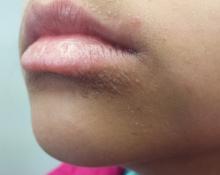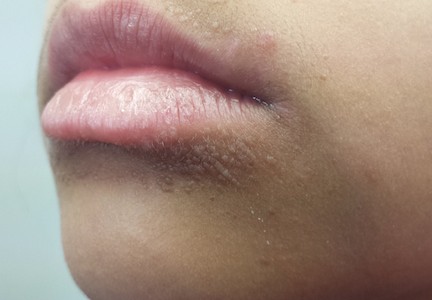User login
A 12-year-old girl is referred by her pediatrician for evaluation and treatment of facial lesions. She’s had them for almost five years, and several treatment attempts have been unsuccessful. Most recently, she tried topical adapalene gel for presumed acne, but this only irritated the area and had no beneficial effect on the “bumps.” Oral antibiotics did not help, either.
The presenting complaint is complicated somewhat by the fact that the same area of her skin is often dark—a problem thought to be related. The patient admits to licking her lips frequently (something her parents have also observed).
The patient’s history is significant for Hodgkin’s lymphoma, diagnosed and successfully treated five years ago. It was around that time that the bumps first appeared, while she was undergoing chemotherapy.
EXAMINATION
There is a ring of sharply demarcated, modest hyperpigmentation around the entire perioral area, extending outward about 2 cm. Closer questioning reveals that this aspect of the problem “comes and goes.”
The main concern is the collection of planar, pinkish brown papules around the mouth. These are mostly located inferior to the lips, although a few tiny papules are on the maxilla. All papules are uniform in size (≤ 1 mm) and shape. None are inflamed or umbilicated.
Continue for Joe Monroe's diagnosis and discussion >>
DISCUSSION
The HPV family has more than 100 distinct DNA types, several of which have particular morphologic characteristics and favored locations. Depending on the affected site, warts can assume many appearances, including planar (flat-topped) papules that generally favor the legs and face of a child or adolescent. Chemotherapy made this patient susceptible, and the lack of a diagnosis in the intervening years compounded the problem.
The perioral hyperpigmentation is, of course, secondary to her lip licking, which dries and irritates the thin facial skin. On a blond or red-haired, fair-skinned patient, it would appear pink or red. But with our patient’s type IV skin, inflammation begets darkening. The two problems are probably unrelated.
Treatment of flat warts on the face of a young woman is problematic, especially when dark skin is a factor. Treatments such as liquid nitrogen would not only be painful if applied to the face but could also cause permanent pigment changes. Irritants and acids (eg, cantharidin or salicylic acid) would have that same potential, so we tend to treat this area with the least invasive, least irritating modalities, knowing that the perfect treatment has yet to be invented.
A sinecatechins ointment —a botanical product made from the extract of green tea leaves—was prescribed. The patient was instructed to apply it three times per day for a month, then return to the clinic for re-evaluation. Treatment alternatives at that point will include imiquimod, which stimulates the skin to produce interferon (known to discourage viral growth) and 5-fluorouracil (5FU) cream, which has also been used with some success for warts. (For the record, I have no financial interest in any of these products.)
Chances are good that with time and treatment, the patient’s warts will disappear. It should be noted that the differential included acne, molluscum contagiosum, and perioral dermatitis. A simple shallow shave biopsy could have been performed to confirm the diagnosis, if necessary.
TAKE-HOME LEARNING POINTS
• The HPV family of warts contains more than 100 distinct genomic types, which can present in a wide variety of morphologies.
• Flat warts (verucca planae) are commonly seen on faces and legs but can appear in other locations. Shaving spreads them.
• No perfect treatment for warts exists. All have drawbacks, including potential for irritation, pain, and dyschromia—the latter a particular problem for patients with darker skin.
• For these patients, sinecatechins ointment, imiquimod, and 5-fluorouracil cream are decent choices.
A 12-year-old girl is referred by her pediatrician for evaluation and treatment of facial lesions. She’s had them for almost five years, and several treatment attempts have been unsuccessful. Most recently, she tried topical adapalene gel for presumed acne, but this only irritated the area and had no beneficial effect on the “bumps.” Oral antibiotics did not help, either.
The presenting complaint is complicated somewhat by the fact that the same area of her skin is often dark—a problem thought to be related. The patient admits to licking her lips frequently (something her parents have also observed).
The patient’s history is significant for Hodgkin’s lymphoma, diagnosed and successfully treated five years ago. It was around that time that the bumps first appeared, while she was undergoing chemotherapy.
EXAMINATION
There is a ring of sharply demarcated, modest hyperpigmentation around the entire perioral area, extending outward about 2 cm. Closer questioning reveals that this aspect of the problem “comes and goes.”
The main concern is the collection of planar, pinkish brown papules around the mouth. These are mostly located inferior to the lips, although a few tiny papules are on the maxilla. All papules are uniform in size (≤ 1 mm) and shape. None are inflamed or umbilicated.
Continue for Joe Monroe's diagnosis and discussion >>
DISCUSSION
The HPV family has more than 100 distinct DNA types, several of which have particular morphologic characteristics and favored locations. Depending on the affected site, warts can assume many appearances, including planar (flat-topped) papules that generally favor the legs and face of a child or adolescent. Chemotherapy made this patient susceptible, and the lack of a diagnosis in the intervening years compounded the problem.
The perioral hyperpigmentation is, of course, secondary to her lip licking, which dries and irritates the thin facial skin. On a blond or red-haired, fair-skinned patient, it would appear pink or red. But with our patient’s type IV skin, inflammation begets darkening. The two problems are probably unrelated.
Treatment of flat warts on the face of a young woman is problematic, especially when dark skin is a factor. Treatments such as liquid nitrogen would not only be painful if applied to the face but could also cause permanent pigment changes. Irritants and acids (eg, cantharidin or salicylic acid) would have that same potential, so we tend to treat this area with the least invasive, least irritating modalities, knowing that the perfect treatment has yet to be invented.
A sinecatechins ointment —a botanical product made from the extract of green tea leaves—was prescribed. The patient was instructed to apply it three times per day for a month, then return to the clinic for re-evaluation. Treatment alternatives at that point will include imiquimod, which stimulates the skin to produce interferon (known to discourage viral growth) and 5-fluorouracil (5FU) cream, which has also been used with some success for warts. (For the record, I have no financial interest in any of these products.)
Chances are good that with time and treatment, the patient’s warts will disappear. It should be noted that the differential included acne, molluscum contagiosum, and perioral dermatitis. A simple shallow shave biopsy could have been performed to confirm the diagnosis, if necessary.
TAKE-HOME LEARNING POINTS
• The HPV family of warts contains more than 100 distinct genomic types, which can present in a wide variety of morphologies.
• Flat warts (verucca planae) are commonly seen on faces and legs but can appear in other locations. Shaving spreads them.
• No perfect treatment for warts exists. All have drawbacks, including potential for irritation, pain, and dyschromia—the latter a particular problem for patients with darker skin.
• For these patients, sinecatechins ointment, imiquimod, and 5-fluorouracil cream are decent choices.
A 12-year-old girl is referred by her pediatrician for evaluation and treatment of facial lesions. She’s had them for almost five years, and several treatment attempts have been unsuccessful. Most recently, she tried topical adapalene gel for presumed acne, but this only irritated the area and had no beneficial effect on the “bumps.” Oral antibiotics did not help, either.
The presenting complaint is complicated somewhat by the fact that the same area of her skin is often dark—a problem thought to be related. The patient admits to licking her lips frequently (something her parents have also observed).
The patient’s history is significant for Hodgkin’s lymphoma, diagnosed and successfully treated five years ago. It was around that time that the bumps first appeared, while she was undergoing chemotherapy.
EXAMINATION
There is a ring of sharply demarcated, modest hyperpigmentation around the entire perioral area, extending outward about 2 cm. Closer questioning reveals that this aspect of the problem “comes and goes.”
The main concern is the collection of planar, pinkish brown papules around the mouth. These are mostly located inferior to the lips, although a few tiny papules are on the maxilla. All papules are uniform in size (≤ 1 mm) and shape. None are inflamed or umbilicated.
Continue for Joe Monroe's diagnosis and discussion >>
DISCUSSION
The HPV family has more than 100 distinct DNA types, several of which have particular morphologic characteristics and favored locations. Depending on the affected site, warts can assume many appearances, including planar (flat-topped) papules that generally favor the legs and face of a child or adolescent. Chemotherapy made this patient susceptible, and the lack of a diagnosis in the intervening years compounded the problem.
The perioral hyperpigmentation is, of course, secondary to her lip licking, which dries and irritates the thin facial skin. On a blond or red-haired, fair-skinned patient, it would appear pink or red. But with our patient’s type IV skin, inflammation begets darkening. The two problems are probably unrelated.
Treatment of flat warts on the face of a young woman is problematic, especially when dark skin is a factor. Treatments such as liquid nitrogen would not only be painful if applied to the face but could also cause permanent pigment changes. Irritants and acids (eg, cantharidin or salicylic acid) would have that same potential, so we tend to treat this area with the least invasive, least irritating modalities, knowing that the perfect treatment has yet to be invented.
A sinecatechins ointment —a botanical product made from the extract of green tea leaves—was prescribed. The patient was instructed to apply it three times per day for a month, then return to the clinic for re-evaluation. Treatment alternatives at that point will include imiquimod, which stimulates the skin to produce interferon (known to discourage viral growth) and 5-fluorouracil (5FU) cream, which has also been used with some success for warts. (For the record, I have no financial interest in any of these products.)
Chances are good that with time and treatment, the patient’s warts will disappear. It should be noted that the differential included acne, molluscum contagiosum, and perioral dermatitis. A simple shallow shave biopsy could have been performed to confirm the diagnosis, if necessary.
TAKE-HOME LEARNING POINTS
• The HPV family of warts contains more than 100 distinct genomic types, which can present in a wide variety of morphologies.
• Flat warts (verucca planae) are commonly seen on faces and legs but can appear in other locations. Shaving spreads them.
• No perfect treatment for warts exists. All have drawbacks, including potential for irritation, pain, and dyschromia—the latter a particular problem for patients with darker skin.
• For these patients, sinecatechins ointment, imiquimod, and 5-fluorouracil cream are decent choices.

